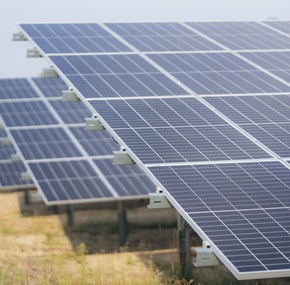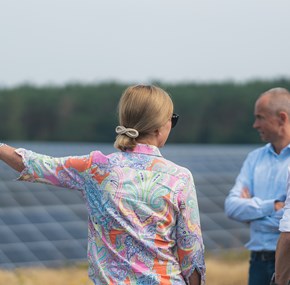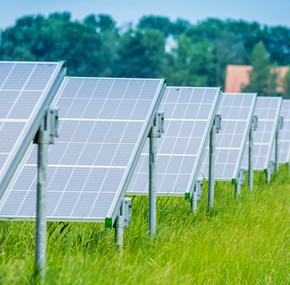Renewables: On the brink of a storage breakthrough?
As even more renewable energy is added to our energy systems, the need for reliable and scalable storage technologies increases. And there is cause for cautious optimism regarding energy storage, explains our expert.
It has become common for national governments to celebrate the days where renewable energy production exceeds domestic electricity demand. In Denmark during this Christmas, for instance, the Danish Energy Association boasted that wind production would cover 110% of domestic electricity demand.
But these stories often fail to mention the fossil-based power plants that are quietly standing by as a necessary back-up to ensure a stable electricity supply. The fluctuating energy production from solar and wind farms has long been seen as an insurmountable obstacle for the transition to a global energy system based on renewables. So much so that the challenge has been dubbed renewable energy’s “Storage problem”.
- A stable energy supply is crucial to any modern economy. Even minor power outages can be catastrophic, and fossil fuels still reign as the most reliable form of stored energy. Until recently, long term and bulk storage of renewable energy has neither been possible nor feasible, says Obton’s Chief Project Officer, Bent Hansen.
Solar-plus-storage catching up
But there are signs that the necessary technology may finally be ready to solve at least some of renewable energy’s storage problems.
A recent report by analysts Wood Mackenzie Power & Renewables calculated that the combination of solar PV plants with batteries is now competitive with the world’s most efficient form of gas power generation in Morocco and Jordan – the so-called combined-cycle gas turbines (CCGTs).
- Obviously it is no coincidence that the case for solar-plus-storage is so convincing in prime solar locations like Jordan and Morocco. But the trend is global, and Wood Mackenzie predicts that the price for storage will drop to 85% by 2023, says Bent Hansen. He adds that the case for solar-plus-storage is also becoming stronger in countries that rely on expensive gas imports.
The rise of the Lithium Ion bettery
Until now, the throne of energy storage has belonged to well-known technologies such as pumped-hydro systems and lithium-ion batteries. Where hydro power has natural limitations with power plants gobbling up enormous amounts of land, lithium-ion batteries have steadily assumed a growing role with falling battery prices and larger battery sizes.
- Li-ion batteries have numerous advantages. They can store large amounts of energy and release it again to the grid within seconds. Furthermore, they are efficient, meaning they return most of the energy that you store in them, says Bent Hansen.
But until now Li-ion battery energy storage systems have not had the sufficient scale to play a significant role in handling peak electricity demand. In most energy systems, sudden increases in electricity demand are handled by so-called peaker plants that are able to quickly deliver a sufficiently large output. As these plants typically run on gas and are often only operational a few hours a day, they are not only very expensive, but also heavy in CO2-emissions.
Li-ion battery storage systems, however, will soon be able to fill the role of peaker plants. And a number of other storage technologies also look promising.
The ingenuity of energy storage
The Li-ion battery’s lesser-known cousin, the flow battery, is also drawing the attention of investors and the energy sector. A flow battery is a type of rechargeable battery where two chemical components are separated by a membrane, and has the advantage that it can be almost instantly recharged. This technology has caught the eye of large investors and the market is expected to grow to $4.5 billion by 2028.
But significant research is also being invested into mechanical storage. Our most well-known example of mechanical storage is pumped-hydro, where energy is stored by pumping water to a reservoir and releasing it again to a hydro power plant.
Another example is rail energy storage systems, where energy is first stored by driving heavily loaded electrical trains up a hill, and then released by driving the train downhill.
- Compared to Li-ion battery storage, mechanical storage systems, apart from pumped-hydro, are not yet ready to play a major role in energy storage systems. But that can suddenly change, says Bent Hansen.
Overcoming the cobalt roadblock
One driver for research into other forms of energy storage than Li-ion batteries has been the rapidly rising global demand for the key battery ingredient, cobalt.
- The global market for electrical vehicles has really picked up speed in recent years, and as a consequence the price of cobalt has risen because it is a key ingredient in many higher density Li-ion batteries, says Bent Hansen. Between 2016 and 2017 the price of cobalt more than doubled but Wood Mackenzie expects prices to start dropping again.
- Furthermore, high cobalt prices have pushed the industry to focus on finding replacement chemistries for Li-ion batteries. So I expect the high cobalt prices to be little more than a roadblock that will soon be overcome, says Bent Hansen. And he expects that solar-plus-storage solutions will soon be competitive in markets everywhere.
- Energy storage is the missing link in moving to a low carbon energy system, but it will not be so for much longer. We are already seeing impressive efficiency improvements in storage technology and the prices look likely to continue dropping, says Bent Hansen while urging lawmakers to start encouraging more storage projects.







